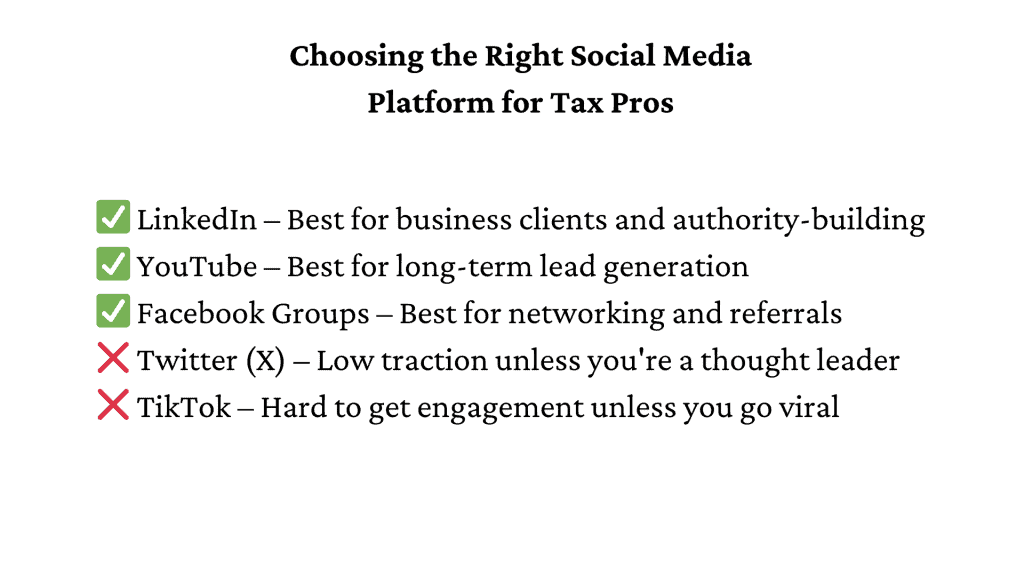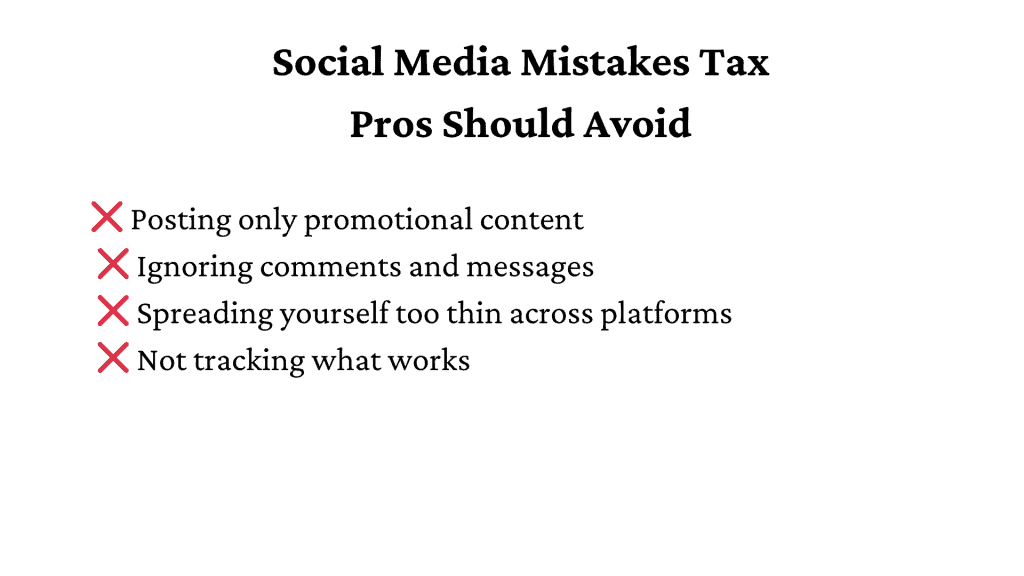Social Media for Tax Pros: What Works & What’s a Waste of Time?
Most people don’t think about taxes until they have to, and by then, they’re usually stressed and looking for help. That’s where social media makes a difference. It keeps you in front of potential clients before they even realize they need you.
Instead of waiting for referrals or seasonal rushes, you can use social media to share quick tax tips, answer common questions, and show people why working with a pro is better than going it alone. When tax season comes around, they won’t be searching for a consultant—they’ll already know you.
You don’t need to post every day or be on every platform. A simple, consistent presence in the right places can bring in leads, build trust, and make sure you’re the first name that comes to mind when someone needs tax help.
Want to attract more clients and scale your tax business faster? Get instant access to our TaxBiz Growth Kit—Click here!
The Biggest Challenge: Choosing the Right Platforms
Many tax consultants dive into social media because they feel like they should, but without a clear plan, it quickly becomes a frustrating time drain. They try posting everywhere, see little engagement, and start wondering if social media even works for tax pros.

The truth is, not all platforms are worth your time. The key is focusing on the ones that actually bring in clients and build your credibility. Instead of wasting hours on platforms that don’t convert, here’s where tax professionals should prioritize their efforts:
✅ LinkedIn – The best platform for networking with business owners, professionals, and potential referral partners. Sharing tax insights, answering common financial questions, and engaging in industry groups can position you as an expert.
✅ YouTube – A long-term client magnet. People search for tax-related questions all the time, and a well-optimized video can bring in leads for years. Short tax tip videos and explainer content work especially well.
✅ Facebook Groups – Instead of relying on a business page that gets little reach, tax pros should engage in local business and entrepreneur groups. Answering questions and providing value in these communities can lead to direct client referrals.
✅ Instagram (if done right) – While not the first choice for tax pros, Instagram can work if you focus on educational Reels, carousels with tax tips, and behind-the-scenes content. It’s a great way to build trust and connect with younger business owners and freelancers.

On the other hand, platforms like Twitter (X) and TikTok are usually not worth the effort unless you’re highly skilled at viral content or want to build a personal brand. Instead of spreading yourself thin, focus on just one or two high-impact platforms and make them work for you.
1. LinkedIn: The Best Platform for B2B & Authority Building
Why It Works
If you want to attract business owners, professionals, and entrepreneurs, LinkedIn is the best place to do it. Unlike other social media platforms, where people are scrolling for entertainment, LinkedIn users are actively looking for insights that can help them grow and manage their businesses—including tax advice.
Think about it. A small business owner is wondering if they should switch from an LLC to an S-Corp. A freelancer is trying to figure out how to deduct their home office expenses. A startup founder is stressed about cash flow and tax planning.
They’re already on LinkedIn, connecting with professionals who can help. If you’re consistently sharing valuable tax tips, answering common questions, and engaging in conversations, you’ll be the expert they turn to when they need tax help.
The best part? Most tax consultants aren’t using LinkedIn effectively. If you show up with the right approach, you’ll stand out quickly.
Post Simple, Practical Tax Tips
Most people don’t want to read long, technical tax articles. What they do want are quick, helpful insights that make their lives easier. Try posting short, easy-to-understand tax tips, like:
💡 “Did you know that if you take a client out for a business meal, you can deduct 50% of the cost? Just make sure to keep a record of the meeting details!”
💡 “LLC or S-Corp? If you’re making over $50K in profit, switching to an S-Corp could save you thousands in self-employment taxes. Ask me how!”
These kinds of posts catch attention, spark engagement, and position you as a helpful expert—without being overly salesy.
Share Real Client Success Stories
People trust professionals who can prove they get results. Instead of just saying, “I help businesses save money on taxes,” share real, relatable success stories (without revealing private details).
For example:
🚀 “A business owner came to me last year worried about a huge tax bill. After reviewing their expenses, I found a few deductions they had completely missed. We ended up saving them over $7,000! If you’re not sure if you’re taking advantage of all the tax breaks available to you, let’s chat.”
This kind of storytelling makes people think, “I might be missing out on tax savings too!”—and that’s when they’ll reach out to you.
Engage in Business Groups & Conversations
LinkedIn isn’t just about posting—it’s also about networking. Business owners and entrepreneurs often ask for advice in LinkedIn groups or on their own posts. Instead of waiting for them to come to you, jump into these conversations with helpful insights.
For example, if someone posts:
❓ “Are business coaching expenses tax-deductible?”
You could reply:
✅ “Yes! If the coaching directly helps your business, it’s typically deductible. Just make sure to keep good records. Happy to share more details if you need!”
By actively engaging in discussions, you build relationships and attract potential clients without ever having to ‘sell’ yourself.
Send Connection Requests That Feel Natural
Most people make the mistake of sending generic or salesy LinkedIn messages. Instead, focus on starting a real conversation by offering value.
Here’s a good example of a message that works:
💬 “Hi [Name], I saw you’re running a business in [industry]. I work with business owners to help them keep more of their money by optimizing their taxes. No pressure, but if you ever have a tax question, I’d be happy to help. Let’s connect!”
This keeps things casual, helpful, and low-pressure, making people much more likely to accept your request and start a conversation.
2. YouTube: Evergreen Lead Generation
People Google tax questions all the time, but guess what? They also search for them on YouTube. In fact, YouTube is the second-largest search engine in the world, and tax-related videos get tons of views.
The best part? A video you post today can still bring in views, leads, and clients months—or even years—from now. Unlike social media posts that disappear in a few days, YouTube videos work for you long after you upload them.
Want to create high-quality tax videos? Check out YouTube’s official guide on video SEO and content strategy: YouTube Creator Academy
Think about it. Someone searches for “How do I pay less in taxes as a freelancer?” and finds your video explaining simple tax-saving strategies. They watch, realize you know what you’re talking about, and then reach out to work with you.
That’s the power of YouTube.
How to Use It
Create FAQ Videos Based on Common Questions
Every tax consultant hears the same questions over and over. Why not turn them into short, helpful videos?
Some easy ideas:
🎥 “What’s the difference between an LLC and an S-Corp for taxes?”
🎥 “How can small business owners pay less in taxes?”
🎥 “What deductions can freelancers claim?”
These are the kinds of questions real people are searching for, which means your videos can show up when they need help.
Keep Videos Short and To The Point
People don’t want to sit through a 20-minute explanation. Aim for under 5 minutes and get straight to the value.
For example:
🚀 Introduce the topic quickly (“A lot of business owners wonder if they should choose an LLC or S-Corp. Let’s break it down in simple terms.”)
🚀 Answer the question with clear, actionable advice
🚀 End with a light call-to-action (“If you need help choosing the best option, let’s chat!”)
Short, informative videos keep people engaged and make them more likely to subscribe and reach out.
Use SEO-Friendly Titles
YouTube is a search engine, which means you need titles that match what people are searching for.
Instead of: ❌ “Understanding Tax Structures”
Try: ✅ “LLC vs. S-Corp: Which One Saves You More Money?”
Instead of: ❌ “Tax Tips for Freelancers”
Try: ✅ “How to Pay Less Taxes as a Freelancer (Simple Strategies!)”
Titles like these make your videos easier to find, bringing in more views and potential clients.
3. Facebook Groups & Local Business Communities
Facebook might not be as trendy as TikTok, but it’s still one of the best places to connect with local business owners.
Every day, small business owners ask tax-related questions in Facebook groups—and most of the time, they’re getting advice from people who aren’t even tax pros. That’s your opportunity to step in, provide value, and position yourself as the go-to expert.
The best part? When you help someone in a Facebook group, others see it too. That can lead to more conversations, referrals, and even direct messages from people who need tax help.
How to Use It
Join Local Business Groups & Answer Questions
Find active business groups in your area or niche, like:
📌 “[Your City] Small Business Network”
📌 “Freelancers & Entrepreneurs Community”
📌 “Startup Founders & Business Growth”
Business owners constantly post questions like:
❓ “Are business meals tax-deductible?”
❓ “How do I file taxes as an LLC?”
❓ “Can I write off my car as a business expense?”
When you jump in and provide clear, helpful answers (without selling), people start seeing you as the expert. And when they actually need tax help? They’ll remember your name.
Post Engaging Content on Your Business Page
Most tax pros create a Facebook business page but don’t post much—so it just sits there. Instead, make it valuable by sharing engaging, easy-to-understand tax tips.
A simple way to do this? Start a “Tax Tip Tuesday” series.
Every Tuesday, post a quick tax-saving tip like:
💡 “Did you know that hiring your kids in your business can help you save on taxes legally? Here’s how it works…”
💡 “Freelancers, don’t forget! If you work from home, a portion of your rent and utilities may be deductible.”
Consistently posting keeps you visible and makes it easy for people to share your content with their friends.
Run a Simple Local Ad for $5–$10/Day
If you want to reach even more local business owners, a small Facebook ad can go a long way.
Example ad idea:
📢 “Business owners, are you overpaying on taxes? Many small businesses miss out on thousands in deductions. Let’s make sure you’re not one of them. Schedule a free tax review today!”
With just $5–$10 a day, you can target business owners in your city and bring in leads without cold calling or chasing referrals.
What’s a Waste of Time for Tax Pros?
Not every social media platform will bring in clients, and not every type of post will get attention. Many tax consultants waste time on strategies that don’t work—either because they’re using the wrong platform or posting content that people ignore.
Here’s what to avoid if you don’t want to spin your wheels with social media.
1. Twitter (X) – Unless You’re a Tax Thought Leader
Twitter (now called X) is great for news, politics, and trending topics, but it’s not the best place for tax pros looking to get clients. The reality is, tax-related tweets rarely gain traction unless you have a large following and are seen as an industry expert.
Twitter works well for tax thought leaders—people who write about tax policy, breaking tax news, or deep industry insights. If you’re someone who enjoys commenting on tax law changes and engaging in public discussions, you might find an audience there.
But if your goal is to attract business owners and individual clients, Twitter is not the best use of your time. Most potential clients aren’t searching for tax help on Twitter, and even if they see your tweet, they’re unlikely to take action.
If you do want to share quick insights, LinkedIn is a much better place to do it because business owners are more likely to be active there.
2. Posting Generic “Call Us for Tax Help” Ads

One of the biggest mistakes tax consultants make on social media is posting the same generic message over and over:
“Need tax help? Call us today!”
People scroll right past these posts because they don’t offer any value. Most business owners and individuals aren’t actively looking for a tax professional while they’re browsing social media. They’ll only pay attention if your content grabs their interest and teaches them something useful.
Instead of generic ads, try this:
- Share a quick tax tip like: “Many freelancers don’t realize they can deduct their home office. If you work from home, you might be missing out on big tax savings.”
- Post a short case study about how you helped a client save money.
- Break down a common misconception about taxes.
When people learn something useful from you, they’re much more likely to remember your name when they need tax help.
3. Spending Too Much Time on TikTok (Unless You Go Viral)
TikTok is an exciting platform, but for most tax professionals, it’s not the best way to get clients. The reality is, tax content isn’t highly shareable on TikTok. People go there for entertainment, and while some educational content does well, it usually needs a mix of humor, fast editing, and strong storytelling to take off.
The only way to succeed on TikTok as a tax pro is if you can consistently create engaging, high-energy videos that get shared widely. If you enjoy making videos and have a knack for breaking down tax concepts in a fun way, it might work. But for most tax professionals, it’s hard to sustain, and the audience may not be actively looking for tax services.
A better alternative? YouTube Shorts.
Short-form videos are becoming more popular, and YouTube Shorts allow you to post quick, valuable content without relying on trends or viral moments. Unlike TikTok, YouTube videos stay searchable over time, meaning your content can bring in clients months or even years after you post it.
Looking to attract more tax clients with paid ads? Check out this step-by-step guide on setting up effective ads as a tax consultant: How to Set Up Ads as a Tax Consultant
If video marketing is part of your strategy, focus on short, informative videos on YouTube rather than spending hours chasing views on TikTok.
Final Tips: How to Make Social Media Work for You
Social media can be a great way to attract clients, but only if you use it strategically. Instead of trying to be everywhere, focus on what actually works.
Pick 1-2 Platforms
Don’t try to post on every platform. Choose the ones where your ideal clients are most active—LinkedIn, YouTube, and Facebook Groups are the best for tax pros.
Post Valuable Content, Not Just Promotions
People don’t follow social media pages just to see ads. Share useful tips, answer common questions, and provide insights that make people see you as an expert.
Batch-Create Content
Instead of scrambling for ideas every day, set aside time each week to create multiple posts at once. This makes it easier to stay consistent without feeling overwhelmed.
Use Simple Tools for Professional Content
Canva is great for creating quick, professional-looking graphics, and CapCut makes video editing simple. You don’t need fancy software to make high-quality posts.
Track What Works and Do More of It
Pay attention to which posts get the most engagement. If people respond well to tax tips or FAQs, create more of that content. Focus on what gets results.
Social media can bring in clients if done right, but not all platforms are worth your time. Stick to LinkedIn, YouTube, and Facebook Groups, and focus on providing value. When you help people first, they’ll remember you when they need tax help.
Not sure which social media platforms actually work for tax pros? This guide breaks down the best platforms like LinkedIn, YouTube, and Facebook Groups

I’m Maqsood, a freelance writer specializing in finance and tech. With experience crafting content for dozens of companies worldwide, I turn complex ideas into engaging stories that connect with audiences. From fintech trends to tax tips, I bring expertise and creativity to every project, delivering content that drives results.


